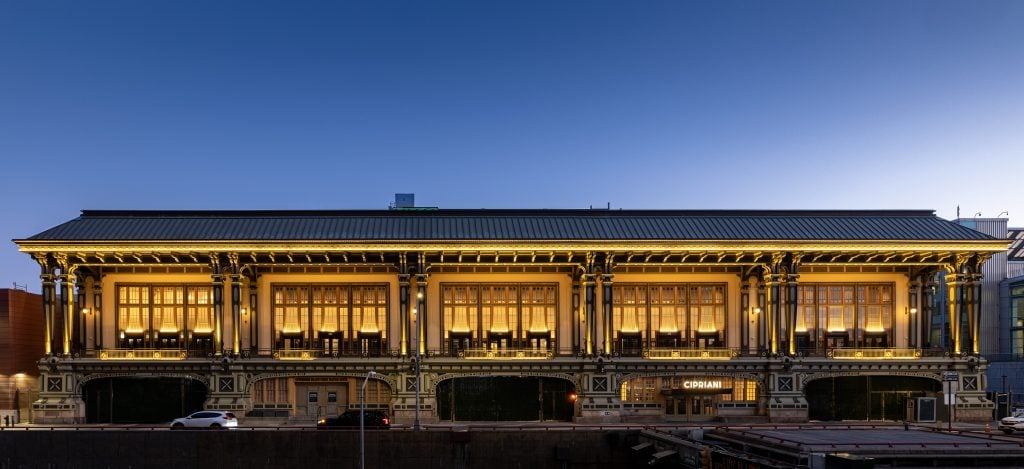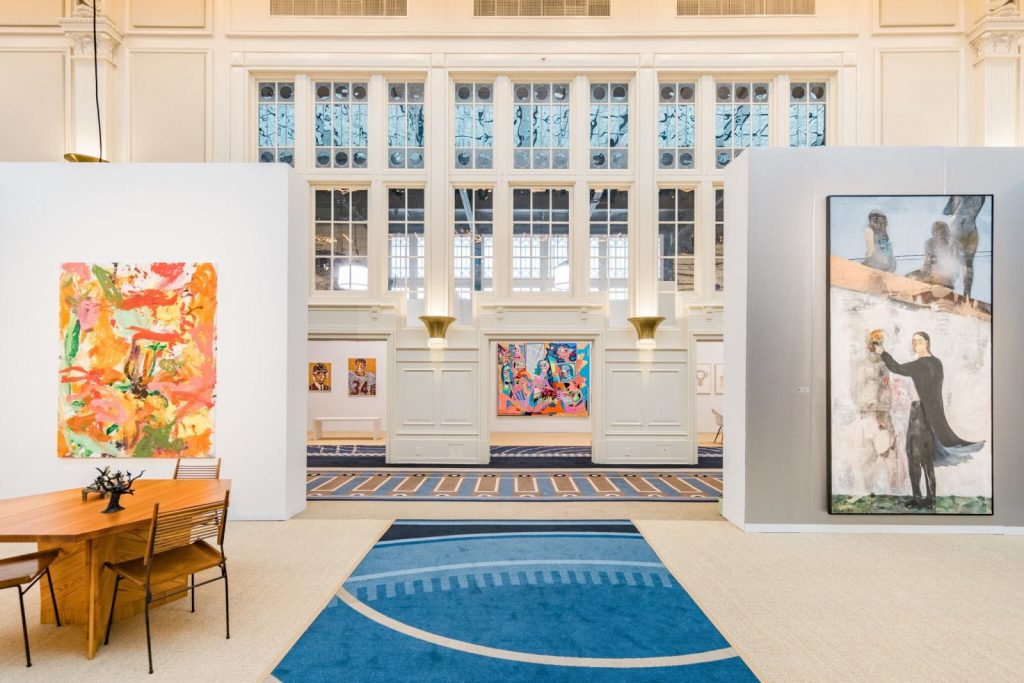The Art Detective
‘The Demand Is Off the Charts’: At the Independent Fair, Young Figurative Painters Steal the Show (and Draw Mile-Long Wait Lists)
Independent offered a peek at the dynamics shaping the broader art market today.

Independent offered a peek at the dynamics shaping the broader art market today.

Katya Kazakina

The Art Detective is a weekly column by Katya Kazakina for Artnet News Pro that lifts the curtain on what’s really going on in the art market.
Cipriani waiters in signature white jackets served champagne on the balcony of a Beaux Arts building by the waterfront in lower Manhattan.
This scene at the Battery Maritime Building greeted hundreds of VIPs arriving in the rain for the opening of Independent, a boutique expo beloved by the globe-trotting art set. The fair’s 12th edition in New York is a coming out of sorts because of the pandemic, which has suspended most live trade shows for over a year. With many European galleries unable to attend, it’s a tighter lineup—28 percent fewer exhibitors than last spring.
Independent and the Armory Show were the last fairs many guests attended before lockdown in March 2020. As they return, the stakes are high. Art fair sales, which accounted for 46 percent of annual revenue for galleries in 2019, plummeted to 7 percent during the first half of 2021, according to a new market survey by UBS, which noted “an overwhelming desire” among collectors to return to these events.
For many of Independent’s 43 exhibitors, it’s the first in-person art fair in 18 months. The return is a mix of new and familiar, at once joyful and jittery—with new venues, masked guests, sold-out booths and, yes, fears of contracting COVID. To quell some of these concerns, the organizers required proof of vaccination and set up timed tickets to enter, controlling the number of people. But the quiet aisles masked a steady beat of sales.

Installation view of Independent Art Fair. Courtesy of Independent.
The combination of a recently restored historic building and state-of-the-art ventilation system “feels very clean and safe,” said Elizabeth Dee, a co-founder of Independent. “We had more RSVPs for the opening day than in 2020.”
The market has changed since Independent’s last outing. While sales froze in the immediate aftermath of lockdown, they have picked up swiftly—for some segments of the market—over the past 12 months as the wealthy looked for places to park their cash.
“There are these pockets of incredible demand,” said art advisor Candace Worth. “And then there is more slow and steady.”
While some galleries were contending with mile-long wait lists—specifically, for paintings by young artists that put a twist on figuration—Worth noted that many others were hedging their bets by pre-selling and honoring reserves. “Dealers easily agreed to hold thing on reserve for a few hours, a sign that there was not as much competition,” she noted.
Attendees at Independent’s preview included Miami collectors Don and Mera Rubell, New York’s Susan and Michael Hort, and Los Angeles-based Dean Valentine. Museum brass came out too, led by Max Hollein, director of the Metropolitan Museum of Art. MoMA trustee Jerry Speyer; former Sotheby’s honcho Amy Cappellazzo and UBS collection curator Mary Rozell.

Che Lovelace, Tree and Place (2021 ) at Independent. Courtesy of Various Small Fires.
“There’s no greater pleasure than looking at art,” said Mera Rubell. “I like being in New York. I like seeing the city come back to life. It feels normal, but strange because people are wearing masks.”
She paused to take in three bold, large-scale paintings by Jameson Green, who draws inspiration from Jacob Lawrence, Philip Guston, and Pablo Picasso. Just a few hours into the show, everything of his was sold, with prices ranging from $14,000 to $40,000. Derek Eller Gallery, which represents the 29-year-old artist, sent out a PDF with 18 available works prior to the fair.
“We had 150 people express interest,” said owner Derek Eller. “It’s a matter of matching people with paintings. We want to take care of the people who’ve been supportive of the gallery and also those who can help Jameson’s career.”
A similar scenario played out at multiple galleries showing young female artists and artists of color. “You can’t deny the popularity of young Black figurative painting,” said Chicago dealer Monique Meloche.

Installation view, Mrs. Photo: Alexa Hoyer, courtesy of Independent.
Various Small Fires gallery pre-sold all seven paintings of lush Caribbean landscapes and carnival settings by Che Lovelace, a Trinidad-based artist, each priced at $30,000.
Downs & Ross gallery sold the three canvases in its booth by Rute Merk, a 28-year-old Lithuanian, Berlin-based painter of melancholy and somewhat menacing works that explore the relationship between technology and the figure. Priced at $20,000 to $40,000, they sold to public museums, the gallery said.
Pre-selling is a necessity because of the demand, explained Alex Ross, a co-founder of the downtown New York gallery. There’s a stringent vetting process to weed out potential speculators. Philanthropic history is a must to be considered as a buyer. Asking if the work makes a good investment is a major faux pas.
Peres Projects placed all its paintings by Stanislava Kovalcikova, whose figurative compositions feature gold leaf surfaces and, occasionally, a hole. She had studied with Peter Doig at the Dusseldorf Art Academy in Germany, and one of the paintings depicts the blue-chip artist as a palm tree. Prices ranged from $22,500 to $35,000.
“Nothing is promised tomorrow, fuck it,” said Javier Peres, the founder of the gallery, when asked why he pre-sold the show. “We’ve had clients waiting for works. The new people we meet will have to wait.”

Installation view of Independent Art Fair. Courtesy of Independent.
A lot of people will need to wait, it seems. Chicago’s Monique Meloche Gallery had a rough time telling established clients that they couldn’t have a painting by the self-taught New York-based artist Chase Hall. His depictions of Black athletes were all sold—though not technically—at prices ranging from $12,000 to $30,000.
“The demand is off the charts,” said Meloche. “The booth is sold out, but we just don’t know to who.”
She’s been telling people who had bought a painting by Hall that they can’t have a second one. “Chase is very savvy for his young age. He wants more people to have a seat at the table. He doesn’t want to see the same group. He also wants to sell to Black collectors.”
The predicament is becoming familiar to many dealers, who try to balance placing the works by fashionable artists into the best possible collections while expanding the pool of buyers and vetting out hordes of speculators.
“It’s something we’ve been talking about as dealers,” Meloche said. “It’s a collective zeitgeist.”